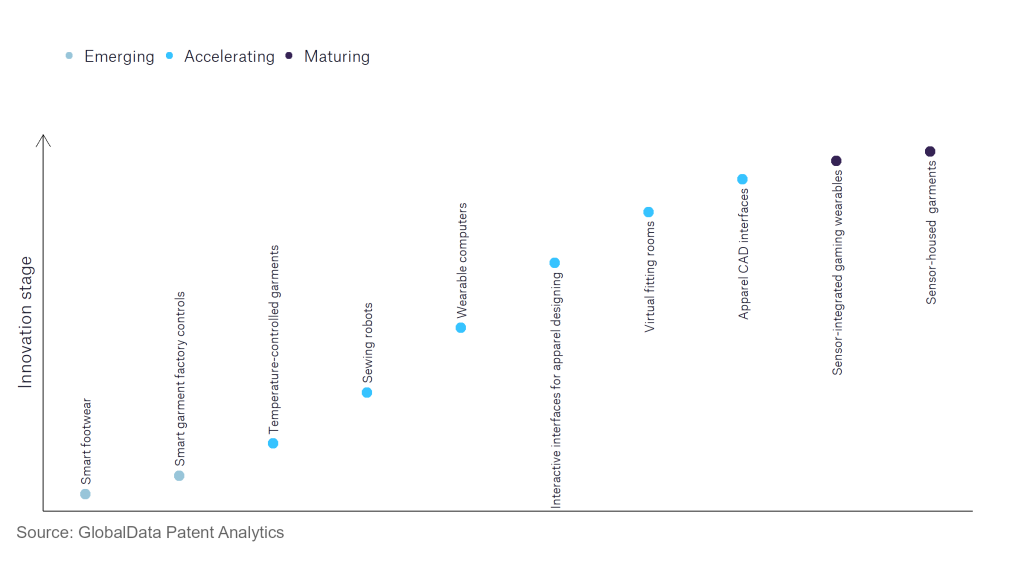The apparel industry continues to be a hotbed of innovation, with activity driven by technology, convenience, and comfort, and the growing importance of technologies such as augmented reality, the internet of things (IoT), artificial intelligence, and digitalisation. In the last three years alone, there have been over 32,000 patents filed and granted in the apparel industry, according to GlobalData’s report on Internet of Things in Apparel: Wearable computers.
However, not all innovations are equal and nor do they follow a constant upward trend. Instead, their evolution takes the form of an S-shaped curve that reflects their typical lifecycle from early emergence to accelerating adoption, before finally stabilising and reaching maturity.
Identifying where a particular innovation is on this journey, especially those that are in the emerging and accelerating stages, is essential for understanding their current level of adoption and the likely future trajectory and impact they will have.
20+ innovations will shape the apparel industry
According to GlobalData’s Technology Foresights, which plots the S-curve for the apparel industry using innovation intensity models built on over 13,000 patents, there are 20+ innovation areas that will shape the future of the industry.
Within the emerging innovation stage, smart footwear and smart garment factory controls are disruptive technologies that are in the early stages of application and should be tracked closely. Temperature-controlled garments, sewing robots, and wearable computers are some of the accelerating innovation areas, where adoption has been steadily increasing. Among maturing innovation areas are sensor integrated gaming wearables and sensor housed garments, which are now well established in the industry.
Innovation S-curve for Internet of Things in the apparel industry

Wearable computers is a key innovation area in Internet of Things
A wearable computer is a small gadget that can be worn as an accessory and is capable of processing as well as storing data. Wearable computers are designed in a way that they are ergonomic, easy to access, and can improve day-to-day tasks by making information quickly available to the wearer.
GlobalData’s analysis also uncovers the companies at the forefront of each innovation area and assesses the potential reach and impact of their patenting activity across different applications and geographies. According to GlobalData, there are 10+ companies, spanning technology vendors, established apparel companies, and up-and-coming start-ups engaged in the development and application of wearable computers.
Key players in wearable computers – a disruptive innovation in the apparel industry
‘Application diversity’ measures the number of different applications identified for each relevant patent and broadly splits companies into either ‘niche’ or ‘diversified’ innovators.
‘Geographic reach’ refers to the number of different countries each relevant patent is registered in and reflects the breadth of geographic application intended, ranging from ‘global’ to ‘local’.
Patent volumes related to wearable computers
| Company | Total patents (2010 - 2021) | Premium intelligence on the world's largest companies |
| NIKE | 281 | Unlock company profile |
| Levi Strauss & Co | 58 | Unlock company profile |
| Gunze | 30 | Unlock company profile |
| Sony Group | 26 | Unlock company profile |
| Apple | 26 | Unlock company profile |
| Alphabet | 15 | Unlock company profile |
| Microsoft | 11 | Unlock company profile |
| Immersion | 10 | Unlock company profile |
| Shenzhen Royole Technologies | 9 | Unlock company profile |
| Samsung Group | 5 | Unlock company profile |
| HP | 5 | Unlock company profile |
Source: GlobalData Patent Analytics
Nike, Levi Strauss, Gunze, Apple, Sony, Alphabet, and Microsoft are among the top players in terms of patents filed in the wearable computers space. In September 2022, Google and Fitbit rolled out a new cloud tool that can help hospitals in collecting and processing data from wearable computers.
The leading players in the wearable computers space in terms of application diversity are Nike, Samsung, Immersion, Sony, and Levi Strauss.
In terms of geographic reach, Nike, Sony, Samsung, HP, and Apple are the top companies.
As technology progresses and more wearable devices are being invented, wearables are finding increasingly diverse applications in various fields from the tracking of physical activities to that of health vitals.
To further understand the key themes and technologies disrupting the apparel industry, access GlobalData’s latest thematic research report on Internet of Things (IoT) in Retail and Apparel.









